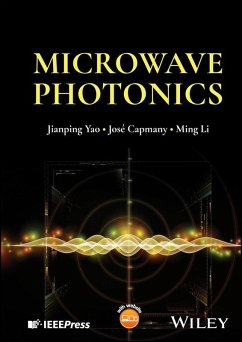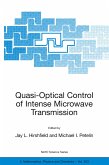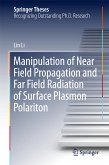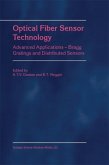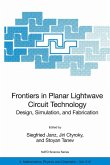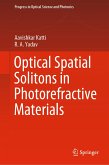

Alle Infos zum eBook verschenken

- Format: PDF
- Merkliste
- Auf die Merkliste
- Bewerten Bewerten
- Teilen
- Produkt teilen
- Produkterinnerung
- Produkterinnerung

Hier können Sie sich einloggen

Bitte loggen Sie sich zunächst in Ihr Kundenkonto ein oder registrieren Sie sich bei bücher.de, um das eBook-Abo tolino select nutzen zu können.
MICROWAVE PHOTONICS Overview of techniques in the field of microwave photonics, including recent developments in quantum microwave photonics and integrated microwave photonics Microwave Photonics offers a comprehensive overview of the microwave photonic techniques developed in the last 30 years, covering topics such as photonics generation of microwave signals, photonics processing of microwave signals, photonics distribution of microwave signals, photonic generation and distribution of UWB signals, photonics generation and processing of arbitrary microwave waveforms, photonic true time delay…mehr
- Geräte: PC
- mit Kopierschutz
- eBook Hilfe
- Größe: 38.03MB
![Quasi-Optical Control of Intense Microwave Transmission (eBook, PDF) Quasi-Optical Control of Intense Microwave Transmission (eBook, PDF)]() Quasi-Optical Control of Intense Microwave Transmission (eBook, PDF)233,95 €
Quasi-Optical Control of Intense Microwave Transmission (eBook, PDF)233,95 €![Ultra-Wideband, Short-Pulse Electromagnetics 7 (eBook, PDF) Ultra-Wideband, Short-Pulse Electromagnetics 7 (eBook, PDF)]() Ultra-Wideband, Short-Pulse Electromagnetics 7 (eBook, PDF)233,95 €
Ultra-Wideband, Short-Pulse Electromagnetics 7 (eBook, PDF)233,95 €![Manipulation of Near Field Propagation and Far Field Radiation of Surface Plasmon Polariton (eBook, PDF) Manipulation of Near Field Propagation and Far Field Radiation of Surface Plasmon Polariton (eBook, PDF)]() Lin LiManipulation of Near Field Propagation and Far Field Radiation of Surface Plasmon Polariton (eBook, PDF)73,95 €
Lin LiManipulation of Near Field Propagation and Far Field Radiation of Surface Plasmon Polariton (eBook, PDF)73,95 €![Optical Fiber Sensor Technology (eBook, PDF) Optical Fiber Sensor Technology (eBook, PDF)]() Optical Fiber Sensor Technology (eBook, PDF)113,95 €
Optical Fiber Sensor Technology (eBook, PDF)113,95 €![Frontiers in Planar Lightwave Circuit Technology (eBook, PDF) Frontiers in Planar Lightwave Circuit Technology (eBook, PDF)]() Frontiers in Planar Lightwave Circuit Technology (eBook, PDF)161,95 €
Frontiers in Planar Lightwave Circuit Technology (eBook, PDF)161,95 €![Optical Spatial Solitons in Photorefractive Materials (eBook, PDF) Optical Spatial Solitons in Photorefractive Materials (eBook, PDF)]() Aavishkar KattiOptical Spatial Solitons in Photorefractive Materials (eBook, PDF)113,95 €
Aavishkar KattiOptical Spatial Solitons in Photorefractive Materials (eBook, PDF)113,95 €![Physics of Classical Electromagnetism (eBook, PDF) Physics of Classical Electromagnetism (eBook, PDF)]() Minoru FujimotoPhysics of Classical Electromagnetism (eBook, PDF)81,95 €
Minoru FujimotoPhysics of Classical Electromagnetism (eBook, PDF)81,95 €-
-
-
Dieser Download kann aus rechtlichen Gründen nur mit Rechnungsadresse in A, B, BG, CY, CZ, D, DK, EW, E, FIN, F, GR, HR, H, IRL, I, LT, L, LR, M, NL, PL, P, R, S, SLO, SK ausgeliefert werden.
- Produktdetails
- Verlag: John Wiley & Sons
- Seitenzahl: 496
- Erscheinungstermin: 6. März 2024
- Englisch
- ISBN-13: 9781394205295
- Artikelnr.: 70176313
- Verlag: John Wiley & Sons
- Seitenzahl: 496
- Erscheinungstermin: 6. März 2024
- Englisch
- ISBN-13: 9781394205295
- Artikelnr.: 70176313
- Herstellerkennzeichnung Die Herstellerinformationen sind derzeit nicht verfügbar.
About the Companion Website xiii
1 Introduction to Microwave Photonics 1
1.1 Photonic Generation of Microwave Signals 1
1.2 Photonic Microwave Signal Processing 1
1.3 Photonic Distribution of Microwave Signals 2
1.4 Photonic Generation of Ultra-wideband Signals 2
1.5 Photonic Generation of Microwave Arbitrary Waveforms 3
1.6 Microwave Photonic Beamforming Networks for Phased Array Antennas 3
1.7 Photonic-Assisted Instantaneous Microwave Frequency Measurements 3
1.8 Microwave Photonic Sensors 4
1.9 Photonic Analog-to-Digital Conversion 4
1.10 Novel Optoelectronic Oscillators 4
1.11 Quantum Microwave Photonics 5
1.12 Integrated Microwave Photonics 5
1.13 Applications of Microwave Photonics 5
2 Optical Devices for Microwave Photonics 7
2.1 Introduction 7
2.2 Optical Fibers and Planar Waveguides 7
2.2.1 Structure and Geometry of Optical Fibers and Planar Waveguides 8
2.2.2 Basic Electromagnetic Theory for Optical Fibers and Planar Waveguides
10
2.2.3 Propagation in Optical Fibers 12
2.2.4 Propagation in Planar Dielectric Waveguides 21
2.3 Light Sources, Detectors, and Modulators 24
2.3.1 Fundamentals of the Interaction Between Radiation and Matter 24
2.3.2 Semiconductor Materials for Optical Sources and Detectors 27
2.3.3 Optical Sources 38
2.3.4 Optical Detectors 59
2.3.5 Optical Modulators 66
2.4 Fiber Bragg Gratings 73
2.4.1 Theory and Design of Fiber Bragg Grating Filters 75
2.4.2 Performance Characteristics of FBGs 77
2.5 Array Waveguide Gratings 79
2.6 Other Passive Components 82
2.6.1 2 × 2 Couplers 82
2.6.2 Isolators 83
2.6.3 Circulators 84
2.7 Chapter Summary 86
References 86
3 Photonic Generation of Microwave Signals 87
3.1 Introduction 87
3.2 Optical Injection Locking 88
3.3 Optical Phase-Locked Loop 89
3.4 Optical Injection Phase Locking 90
3.5 Microwave Generation Based on External Modulation 91
3.5.1 Intensity Modulator-Based Approach 91
3.5.2 Phase-Modulator-Based Approach 92
3.6 Microwave Generation Using a Dual-Wavelength Laser 93
3.7 Microwave Generation Using an Optoelectronic Oscillator 96
3.8 Performance Comparison of the Techniques for Photonic Microwave
Generation 99
3.9 Summary 101
References 101
4 Photonic-Assisted Microwave Signal Processing 105
4.1 Introduction 105
4.2 Microwave Photonic Filters 105
4.2.1 Photonic Microwave Delay-Line Filters with Negative Coefficients 107
4.2.2 Photonic Microwave Delay-Line Filters with Complex Coefficients 114
4.2.3 Nonuniformly Spaced Photonic Microwave Delay-Line Filters 116
4.3 Optical Mixing of Microwave Signals 119
4.4 Coherent Microwave Photonic Filters 123
4.5 Dynamic Range of a Microwave Photonic Filter 131
4.6 Conclusion 132
References 133
5 Photonic Distribution of Microwave Signals 137
5.1 Introduction 137
5.2 Introduction to Microwave Photonics Links 137
5.3 Figures of Merit of a Simple Microwave Photonic Link 138
5.3.1 RF Gain 139
5.3.2 Noise 141
5.3.3 Dynamic Range 142
5.4 Figures of Merit of a Filtered Microwave Photonic Link 148
5.4.1 Filtered Intensity Modulated Direct Detection Links 149
5.4.2 Filtered Phase Modulated Links 152
5.4.3 Application Examples 155
5.5 Introduction to Fiber-Wireless Systems 156
5.6 Optical Transport of Wireless Signals 157
5.6.1 Radio Over Fiber 157
5.6.2 Intermediate Frequency Over Fiber 158
5.6.3 Baseband Over Fiber 159
5.7 Sources of Degradation and Impairments 160
5.7.1 Chromatic Dispersion 160
5.7.2 Optical Nonlinearities 163
5.8 Fiber-Wireless Networks 165
5.8.1 Spectral Efficiency 165
5.8.2 Optical Subsystems for Fiber-Wireless Networks 166
5.8.3 Application Scenarios 171
5.9 Chapter Summary 174
Problems 175
References 176
6 Photonic Generation of Ultra-Wideband Signals 181
6.1 Introduction 181
6.2 UWB Pulse Generation Based on PM-IM Conversion 182
6.2.1 Optical Phase Modulation 183
6.2.2 PM-IM Conversion 183
6.2.3 UWB Pulse Generation Based on PM-IM Conversion in a Dispersive Device
189
6.2.4 UWB Pulse Generation Based on PM-IM Conversion in an Optical
Frequency Discriminator 191
6.3 UWB Pulse Generation Based on a Photonic Microwave Delay Line Filter
195
6.3.1 Photonic Microwave Delay-Line Filters for UWB Pulse Generation 196
6.3.2 UWB Monocycle Generation with a Two-Tap Microwave Delay-Lines Filter
198
6.3.3 UWB Doublet Generation with a Three-Tap Microwave Delay-Line Filter
200
6.4 UWB Pulse Generation based on Spectral Shaping and Frequency-to-Time
Mapping 201
6.4.1 UWB Pulse Generation Based on Optical Spectral Shaping and
Frequency-to-Time Mapping 202
6.4.2 Implementation of All-Fiber UWB Pulse Generation based on Spectral
Shaping and Frequency-to-Time Mapping 203
6.5 Discussion and Conclusion 205
References 206
7 Photonic Generation of Microwave Arbitrary Waveforms 209
7.1 Introduction 209
7.2 Direct Space-to-Time Pulse Shaping 209
7.3 Spectral-Shaping and Wavelength-to-Time Mapping 213
7.4 Temporal Pulse Shaping 221
7.5 Microwave Waveform Generation Based on a Photonic Microwave Delay-Line
Filter 228
7.6 Conclusion 233
References 234
8 Microwave Photonics Beamforming Networks for Phased Array Antennas 237
8.1 Introduction 237
8.2 Basic Concepts on Phased Array Antennas 238
8.2.1 Principles of Operation 238
8.2.2 Design Parameters 241
8.2.3 PAA Feed Architectures 245
8.3 True Time Delay Optical Beamforming Networks 246
8.4 Phase-Shift Optical Beamforming Networks 264
8.5 Summary and Conclusions 269
Problems 269
References 271
9 Photonic-Assisted Instantaneous Frequency Measurements 277
9.1 Introduction 277
9.2 Frequency Measurement Using an Optical Channelizer 279
9.2.1 Optical Phased-Array WDM 280
9.2.2 Free-Space Diffraction Grating 281
9.2.3 Phase-Shifted Chirped Fiber Bragg Grating Arrays 282
9.2.4 Integrated Optical Bragg Grating Fabry-Perot Etalon 283
9.3 Frequency Measurement Based on Power Monitoring 283
9.3.1 Chromatic Dispersion-Induced Microwave Power Penalty 284
9.3.2 Break the Lower Frequency Bound 289
9.3.3 IFM Based on Photonic Microwave Filters with Complementary Frequency
Responses 292
9.3.4 First-Order Photonic Microwave Differentiator 294
9.3.5 Optical Power Fading Using Optical Filters 297
9.4 Other Methods for Frequency Measurement 299
9.4.1 Fabry-Perot Scanning Receiver 299
9.4.2 Photonic Hilbert Transform 300
9.4.3 Monolithically Integrated EDG 301
9.4.4 Incoherent Frequency-to-Time Mapping 301
9.5 Conclusion 303
References 304
10 Microwave Photonic Sensors 309
10.1 Introduction 309
10.2 Optical Sensors Based on a Dual-Wavelength Laser Source 310
10.3 Optical Sensors Based on an Optoelectronic Oscillator 314
10.4 Optical Sensors Based on Spectrum Shaping and Wavelength-to-Time
Mapping 321
10.5 Photonic Integrated Microwave Photonic Sensors 326
10.6 Conclusion 329
References 330
11 Photonic Analog-to-Digital Conversion 333
11.1 Introduction 333
11.2 Basic Concepts on Analog-to-Digital Converters 334
11.2.1 Types of Converters 334
11.2.2 Operation Principles of the Nyquist ADC 335
11.2.3 State of the Art of Electronic ADCs 338
11.2.4 Classification of Photonic ADCs 340
11.3 Photonic-Assisted ADCs 340
11.3.1 Classification of Photonic-Assisted ADCs 340
11.3.2 Optically Clocked Track-and-Hold Circuits 341
11.3.3 Optical Replication Pre-Processors 343
11.3.4 Optical Time-Stretched Pre-Processors 345
11.4 Photonic Sampled/Electronic Quantized ADCs 347
11.5 Electronic Sampled/Photonic Quantized ADCs 354
11.6 Photonic Sampled/Photonic Quantized ADCs 355
11.6.1 Classification of Photonic Sampled/Photonic Quantized Converters 355
11.6.2 Intensity Modulation and Conversion 355
11.6.3 Intensity Modulation and Optical Comparator 358
11.6.4 Phase Modulation and Optical Beam Deflection 358
11.7 Chapter Summary 361
Problems 361
References 363
12 Novel Optoelectronic Oscillators 367
12.1 Introduction 367
12.2 Models for Optoelectronic Oscillators 368
12.3 Parity-Time Symmetric OEO 378
12.4 Fourier Domain Mode-Locked OEO 382
12.5 OEPO 385
12.6 Broad Random OEO 388
12.7 Integrated OEO 392
12.8 Discussion and Conclusion 395
References 396
13 Integrated Microwave Photonics 401
13.1 Introduction 401
13.2 Integration Technologies and Platforms 403
13.2.1 Indium Phosphide 403
13.2.2 Silicon Photonics 405
13.2.3 Silicon Nitride 405
13.2.4 Other Platforms 406
13.2.5 Comparative Analysis 406
13.3 Application-Specific Photonic Integrated Circuits for Microwave
Photonics 408
13.3.1 Filters 409
13.3.2 Microwave Signal Generators 409
13.3.2.1 Optoelectronic Oscillators 411
13.3.2.2 Comb Sources 413
13.3.2.3 IR-UWB Generators 413
13.3.2.4 Arbitrary Waveform Generators 415
13.3.3 Tunable True Time Delay Lines and Phase Shifters 419
13.3.4 Optical Beamforming 421
13.4 Multifunctional Circuits 424
13.5 Universal Microwave Photonic Processors 426
13.5.1 Early Designs 427
13.5.2 Waveguide Mesh Core Processors 428
13.5.3 Waveguide Mesh MWP Universal Processors 434
13.6 Conclusions and Future Prospects 441
References 442
14 Quantum Microwave Photonics 449
14.1 Introduction 449
14.2 Principle of the Single-Photon Detection Scheme 450
14.3 Weak Signal Detection 453
14.4 Quantum Microwave Photonic Signal Processing 454
14.5 Nonlocal Frequency-to-Time Mapping 455
14.6 Compressed Sensing 457
14.7 Microwave Photonic Quantum Key Distribution 458
14.8 Discussion and Conclusion 460
References 461
15 Future and Perspectives 465
15.1 Introduction 465
15.2 Future and Perspectives 465
15.3 Discussion and Conclusion 468
References 468
Index 471
About the Companion Website xiii
1 Introduction to Microwave Photonics 1
1.1 Photonic Generation of Microwave Signals 1
1.2 Photonic Microwave Signal Processing 1
1.3 Photonic Distribution of Microwave Signals 2
1.4 Photonic Generation of Ultra-wideband Signals 2
1.5 Photonic Generation of Microwave Arbitrary Waveforms 3
1.6 Microwave Photonic Beamforming Networks for Phased Array Antennas 3
1.7 Photonic-Assisted Instantaneous Microwave Frequency Measurements 3
1.8 Microwave Photonic Sensors 4
1.9 Photonic Analog-to-Digital Conversion 4
1.10 Novel Optoelectronic Oscillators 4
1.11 Quantum Microwave Photonics 5
1.12 Integrated Microwave Photonics 5
1.13 Applications of Microwave Photonics 5
2 Optical Devices for Microwave Photonics 7
2.1 Introduction 7
2.2 Optical Fibers and Planar Waveguides 7
2.2.1 Structure and Geometry of Optical Fibers and Planar Waveguides 8
2.2.2 Basic Electromagnetic Theory for Optical Fibers and Planar Waveguides
10
2.2.3 Propagation in Optical Fibers 12
2.2.4 Propagation in Planar Dielectric Waveguides 21
2.3 Light Sources, Detectors, and Modulators 24
2.3.1 Fundamentals of the Interaction Between Radiation and Matter 24
2.3.2 Semiconductor Materials for Optical Sources and Detectors 27
2.3.3 Optical Sources 38
2.3.4 Optical Detectors 59
2.3.5 Optical Modulators 66
2.4 Fiber Bragg Gratings 73
2.4.1 Theory and Design of Fiber Bragg Grating Filters 75
2.4.2 Performance Characteristics of FBGs 77
2.5 Array Waveguide Gratings 79
2.6 Other Passive Components 82
2.6.1 2 × 2 Couplers 82
2.6.2 Isolators 83
2.6.3 Circulators 84
2.7 Chapter Summary 86
References 86
3 Photonic Generation of Microwave Signals 87
3.1 Introduction 87
3.2 Optical Injection Locking 88
3.3 Optical Phase-Locked Loop 89
3.4 Optical Injection Phase Locking 90
3.5 Microwave Generation Based on External Modulation 91
3.5.1 Intensity Modulator-Based Approach 91
3.5.2 Phase-Modulator-Based Approach 92
3.6 Microwave Generation Using a Dual-Wavelength Laser 93
3.7 Microwave Generation Using an Optoelectronic Oscillator 96
3.8 Performance Comparison of the Techniques for Photonic Microwave
Generation 99
3.9 Summary 101
References 101
4 Photonic-Assisted Microwave Signal Processing 105
4.1 Introduction 105
4.2 Microwave Photonic Filters 105
4.2.1 Photonic Microwave Delay-Line Filters with Negative Coefficients 107
4.2.2 Photonic Microwave Delay-Line Filters with Complex Coefficients 114
4.2.3 Nonuniformly Spaced Photonic Microwave Delay-Line Filters 116
4.3 Optical Mixing of Microwave Signals 119
4.4 Coherent Microwave Photonic Filters 123
4.5 Dynamic Range of a Microwave Photonic Filter 131
4.6 Conclusion 132
References 133
5 Photonic Distribution of Microwave Signals 137
5.1 Introduction 137
5.2 Introduction to Microwave Photonics Links 137
5.3 Figures of Merit of a Simple Microwave Photonic Link 138
5.3.1 RF Gain 139
5.3.2 Noise 141
5.3.3 Dynamic Range 142
5.4 Figures of Merit of a Filtered Microwave Photonic Link 148
5.4.1 Filtered Intensity Modulated Direct Detection Links 149
5.4.2 Filtered Phase Modulated Links 152
5.4.3 Application Examples 155
5.5 Introduction to Fiber-Wireless Systems 156
5.6 Optical Transport of Wireless Signals 157
5.6.1 Radio Over Fiber 157
5.6.2 Intermediate Frequency Over Fiber 158
5.6.3 Baseband Over Fiber 159
5.7 Sources of Degradation and Impairments 160
5.7.1 Chromatic Dispersion 160
5.7.2 Optical Nonlinearities 163
5.8 Fiber-Wireless Networks 165
5.8.1 Spectral Efficiency 165
5.8.2 Optical Subsystems for Fiber-Wireless Networks 166
5.8.3 Application Scenarios 171
5.9 Chapter Summary 174
Problems 175
References 176
6 Photonic Generation of Ultra-Wideband Signals 181
6.1 Introduction 181
6.2 UWB Pulse Generation Based on PM-IM Conversion 182
6.2.1 Optical Phase Modulation 183
6.2.2 PM-IM Conversion 183
6.2.3 UWB Pulse Generation Based on PM-IM Conversion in a Dispersive Device
189
6.2.4 UWB Pulse Generation Based on PM-IM Conversion in an Optical
Frequency Discriminator 191
6.3 UWB Pulse Generation Based on a Photonic Microwave Delay Line Filter
195
6.3.1 Photonic Microwave Delay-Line Filters for UWB Pulse Generation 196
6.3.2 UWB Monocycle Generation with a Two-Tap Microwave Delay-Lines Filter
198
6.3.3 UWB Doublet Generation with a Three-Tap Microwave Delay-Line Filter
200
6.4 UWB Pulse Generation based on Spectral Shaping and Frequency-to-Time
Mapping 201
6.4.1 UWB Pulse Generation Based on Optical Spectral Shaping and
Frequency-to-Time Mapping 202
6.4.2 Implementation of All-Fiber UWB Pulse Generation based on Spectral
Shaping and Frequency-to-Time Mapping 203
6.5 Discussion and Conclusion 205
References 206
7 Photonic Generation of Microwave Arbitrary Waveforms 209
7.1 Introduction 209
7.2 Direct Space-to-Time Pulse Shaping 209
7.3 Spectral-Shaping and Wavelength-to-Time Mapping 213
7.4 Temporal Pulse Shaping 221
7.5 Microwave Waveform Generation Based on a Photonic Microwave Delay-Line
Filter 228
7.6 Conclusion 233
References 234
8 Microwave Photonics Beamforming Networks for Phased Array Antennas 237
8.1 Introduction 237
8.2 Basic Concepts on Phased Array Antennas 238
8.2.1 Principles of Operation 238
8.2.2 Design Parameters 241
8.2.3 PAA Feed Architectures 245
8.3 True Time Delay Optical Beamforming Networks 246
8.4 Phase-Shift Optical Beamforming Networks 264
8.5 Summary and Conclusions 269
Problems 269
References 271
9 Photonic-Assisted Instantaneous Frequency Measurements 277
9.1 Introduction 277
9.2 Frequency Measurement Using an Optical Channelizer 279
9.2.1 Optical Phased-Array WDM 280
9.2.2 Free-Space Diffraction Grating 281
9.2.3 Phase-Shifted Chirped Fiber Bragg Grating Arrays 282
9.2.4 Integrated Optical Bragg Grating Fabry-Perot Etalon 283
9.3 Frequency Measurement Based on Power Monitoring 283
9.3.1 Chromatic Dispersion-Induced Microwave Power Penalty 284
9.3.2 Break the Lower Frequency Bound 289
9.3.3 IFM Based on Photonic Microwave Filters with Complementary Frequency
Responses 292
9.3.4 First-Order Photonic Microwave Differentiator 294
9.3.5 Optical Power Fading Using Optical Filters 297
9.4 Other Methods for Frequency Measurement 299
9.4.1 Fabry-Perot Scanning Receiver 299
9.4.2 Photonic Hilbert Transform 300
9.4.3 Monolithically Integrated EDG 301
9.4.4 Incoherent Frequency-to-Time Mapping 301
9.5 Conclusion 303
References 304
10 Microwave Photonic Sensors 309
10.1 Introduction 309
10.2 Optical Sensors Based on a Dual-Wavelength Laser Source 310
10.3 Optical Sensors Based on an Optoelectronic Oscillator 314
10.4 Optical Sensors Based on Spectrum Shaping and Wavelength-to-Time
Mapping 321
10.5 Photonic Integrated Microwave Photonic Sensors 326
10.6 Conclusion 329
References 330
11 Photonic Analog-to-Digital Conversion 333
11.1 Introduction 333
11.2 Basic Concepts on Analog-to-Digital Converters 334
11.2.1 Types of Converters 334
11.2.2 Operation Principles of the Nyquist ADC 335
11.2.3 State of the Art of Electronic ADCs 338
11.2.4 Classification of Photonic ADCs 340
11.3 Photonic-Assisted ADCs 340
11.3.1 Classification of Photonic-Assisted ADCs 340
11.3.2 Optically Clocked Track-and-Hold Circuits 341
11.3.3 Optical Replication Pre-Processors 343
11.3.4 Optical Time-Stretched Pre-Processors 345
11.4 Photonic Sampled/Electronic Quantized ADCs 347
11.5 Electronic Sampled/Photonic Quantized ADCs 354
11.6 Photonic Sampled/Photonic Quantized ADCs 355
11.6.1 Classification of Photonic Sampled/Photonic Quantized Converters 355
11.6.2 Intensity Modulation and Conversion 355
11.6.3 Intensity Modulation and Optical Comparator 358
11.6.4 Phase Modulation and Optical Beam Deflection 358
11.7 Chapter Summary 361
Problems 361
References 363
12 Novel Optoelectronic Oscillators 367
12.1 Introduction 367
12.2 Models for Optoelectronic Oscillators 368
12.3 Parity-Time Symmetric OEO 378
12.4 Fourier Domain Mode-Locked OEO 382
12.5 OEPO 385
12.6 Broad Random OEO 388
12.7 Integrated OEO 392
12.8 Discussion and Conclusion 395
References 396
13 Integrated Microwave Photonics 401
13.1 Introduction 401
13.2 Integration Technologies and Platforms 403
13.2.1 Indium Phosphide 403
13.2.2 Silicon Photonics 405
13.2.3 Silicon Nitride 405
13.2.4 Other Platforms 406
13.2.5 Comparative Analysis 406
13.3 Application-Specific Photonic Integrated Circuits for Microwave
Photonics 408
13.3.1 Filters 409
13.3.2 Microwave Signal Generators 409
13.3.2.1 Optoelectronic Oscillators 411
13.3.2.2 Comb Sources 413
13.3.2.3 IR-UWB Generators 413
13.3.2.4 Arbitrary Waveform Generators 415
13.3.3 Tunable True Time Delay Lines and Phase Shifters 419
13.3.4 Optical Beamforming 421
13.4 Multifunctional Circuits 424
13.5 Universal Microwave Photonic Processors 426
13.5.1 Early Designs 427
13.5.2 Waveguide Mesh Core Processors 428
13.5.3 Waveguide Mesh MWP Universal Processors 434
13.6 Conclusions and Future Prospects 441
References 442
14 Quantum Microwave Photonics 449
14.1 Introduction 449
14.2 Principle of the Single-Photon Detection Scheme 450
14.3 Weak Signal Detection 453
14.4 Quantum Microwave Photonic Signal Processing 454
14.5 Nonlocal Frequency-to-Time Mapping 455
14.6 Compressed Sensing 457
14.7 Microwave Photonic Quantum Key Distribution 458
14.8 Discussion and Conclusion 460
References 461
15 Future and Perspectives 465
15.1 Introduction 465
15.2 Future and Perspectives 465
15.3 Discussion and Conclusion 468
References 468
Index 471
